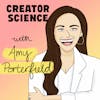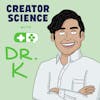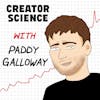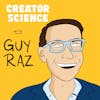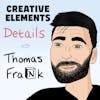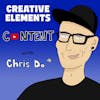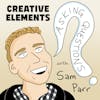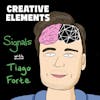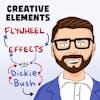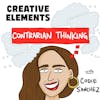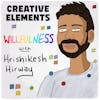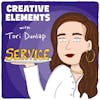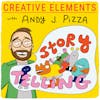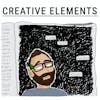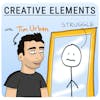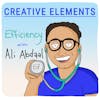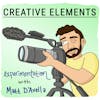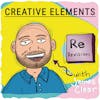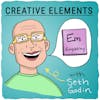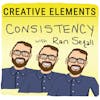
#27: Ran Segall – How a freelance designer's YouTube hobby paved the way to becoming an educator
Play EpisodeRan Segall is the creator of Flux Academy. Previous to Flux, Ran was a freelance designer with nearly 20 years of experience.
Ran Segall is the creator of Flux Academy. Previous to Flux, Ran was a freelance designer with nearly 20 years of experience.
Flux Academy started in 2015 as a YouTube channel called Flux. That channel has 200K subscribers and more than 9M views.
In this episode we talk about Ran’s experience freelancing, what he learned working in a design agency, why he created the Webflow Masterclass, how he pre-sold it to his audience, and why Consistency has allowed him to build an audience and a business larger than himself.
Transcript and show notes can be found here.
***
LISTENER SUPPORT
Join our community on Facebook
Support this show through Buy Me A Coffee.
***
SPONSORS
Try Podia and save 15% for life as a Creative Elements listener
Start your free trial of SavvyCal and get your first month free using promo code ELEMENTS
ABOUT JAY CLOUSE
Subscribe to my weekly newsletter
Enroll in my course on podcasting, Podcast Like The Pros
***
PODGLOMERATE NETWORK
This show is a part of the Podglomerate network, a company that produces, distributes, and monetizes podcasts. We encourage you to visit the website and sign up for our newsletter for more information about our shows, launches, and events. For more information on how The Podglomerate treats data, please see our Privacy Policy.
Since you're listening to Creative Elements, we'd like to suggest you also try other Podglomerate shows surrounding entrepreneurship, business, and careers like Rocketship.fm and Freelance to Founder.
Learn more about your ad choices. Visit megaphone.fm/adchoices
Ran Segall 0:00
That's when I realized, okay, there's something here. Again, I never tried to sell anything to my audience, but when I did, and the reception was so well understood, okay, so there's something here that's working and we need to explore this.
Jay Clouse 0:16
Welcome to Creative Elements, a show where we talk to your favorite creators, and learn what it takes to make a living from your art and creativity. I'm your host, Jay Clouse. Let's start the show.
Jay Clouse 0:42
Hello, my friend, and welcome to another episode of Creative Elements. This week, we're venturing off into the land of YouTube once again. And I'm really excited about this episode because we aren't just going into the land of YouTube. But we're talking about freelancing, design agencies and online courses too. Because today, I'm speaking with Ran Segall, the creator of Flux Academy. Ran lives in Tel Aviv, Israel and has nearly 20 years of experience as a freelance designer, and his personal goals are really well aligned with my own and probably yours, too.
Ran Segall 1:14
Growing up, I had a very simple dream. I want to do something that I love, have the freedom to work with people I want to work with, and have enough money to live the life that I wanted to live.
Jay Clouse 1:25
Flux Academy is an online education platform helping designers build the skills necessary to succeed as independent designers. they've served more than 2500 students. And currently, they do that through three courses. The $10,000 website process, six figure freelancer, and the web flow masterclass. But Flux Academy started as a YouTube channel called Flux. In that clip you just heard is from the channels' welcome video. Ran started the Flux channel in November of 2015. In throughout 2016, he was creating a daily vlog. Since then, the channel has grown to 200,000 subscribers in more than 9 million views. When I spoke with Matt D' Avella in Episode 21 of the show, he brought up an aspect of YouTube that he really loves. And now I think about a lot.
Matt D'Avella 2:11
And this is what I think is great about YouTube in general is that it's so easy to look back at creators and see how they got successful. Like if you want to be a great Youtuber now and you want to build a sustainable YouTube channel. Go back and look at some of your favorite YouTubers. Look how they started, see the first video that took off for them, you know, see how that video was crafted the title, the thumbnail, all those things like we can look back at all these people.
Jay Clouse 2:34
I spent some time digging into Ran's channel. And what's really great about Ran story, as you'll hear, he didn't set out to build a YouTube business at all. Ran loves serving clients through design. In fact, in 2018, Ran shared a conversation with Chris Do of the Futur where he was trying to learn how to earn more as a freelancer while building a software product on the side.
Ran Segall 2:55
Last week at a talk with Chris Do, co founder and CEO of The Futur and Blind. And this was one of the most mind blowing conversation I had in a while and I want to share that conversation with you. Chris is actually teaching me how to double my business by selling high value consultancy.
Jay Clouse 3:15
That whole 45 minute conversation is worth a listen and I'll share it in the show notes. But what really stood out is that Chris really tried to underscore the earning and impact potential of Ran's YouTube channel.
Chris Do 3:27
At some point the YouTube channel depending on your your life ambitions can exceed all other things, including the product business that you're building, who knows.
Jay Clouse 3:37
Things changed quite a bit for Ran since that conversation in late 2019. He actually sold that software product. And about that same time he launched his first course the web flow masterclass, which completely changed the trajectory of his business and his YouTube channel. Today, Ran is focused on building Flux Academy full time. So in this episode, we talk about Ran's experience freelancing, what he learned working in a design agency, why he created the web flow masterclass how he pre sold it to his audience, and why consistency has allowed him to build an audience in a business that's larger than himself. I'll be sharing some of Ran's videos throughout the week in our Creative Elements, listeners group on Facebook. So join us there if you haven't already. And let me know what you think of this episode. You can find me on Twitter or Instagram @JayClouse. I'd love to hear from you. But now, let's hear from Ran.
Ran Segall 4:33
I actually started freelancing back in high school just because, you know, I was toying around with design software as a hobby and just, you know, showed all my friends in school what I was doing so eventually, they told their parents and somehow he kind of evolved into paying gigs, but it was always kind of something that I did for fun. Sometimes I got paid for it, and other times I did not. He wasn't I never thought about ended up kind of a full time freelancer. So I, I think earlier in my career when I was considering I thought about, you know what I have the rest of my life to sit at, at home in my underwear, at least that's what I was saying. So let me hang around people right now. And I wanted to work in creative spaces and learn from other people. And it was only I think, around seven years ago, six or seven years ago, when I went full time into freelancing. So I've thought for about 20 years, I've been doing it kind of part time. And by the way, doing it part time for so long, also enables you to kind of easily transition into full time because you've built a network, you already have a portfolio you're all really familiar with, you know, how project roll, how to price. And so that's helpful, obviously. So that's kind of how things rolled.
Jay Clouse 5:51
At some point, I know you, you worked at an agency as well, I'd love to hear how that experience felt relative to freelancing, you know, done up to that point. And when you decided, you've had enough working at an agency.
Ran Segall 6:05
So I, the way that my kind of design career evolved is that my first actual job, like role, like full time position was in a software company, actually in a gaming company. So kind of like designing banners, emails, stuff like that. And then from there, I moved into a huge advertising agency. So like a really big agency, working on billboards and stuff like that for for big brands. And from there, I kind of moved into a smaller, maybe let's call it mid size, branding agency that does kind of branding projects. And from there, I moved into a startup as a product designer, so I kind of had a broad experience. And I feel like the experience has been different from you know, big advertising agency, where you're kind of a really small bolt in the system. And you have again, I was very low level. So I had our director is basically telling me what to do, it wasn't really very creative role, it was more like execution. But I did learn to execute very fast, and I got tons of software hours. So that was helpful in that sense. But then when I moved into the branding agency, where I got to do branding and more design work, that has been really fantastic. In terms of learning how to. So i've i've been kind of winging freelance on the side, you know, on my own, but I've never seen how to properly do this. And when I worked in an agency, that's the first time where, you know, my boss, the creative director, put me inside the meeting with the client. And then I saw how like, professionals run their, you know, meetings strategy session presenting creative ideas. So I definitely learned a lot from being in that agency. I eventually burned out just because the culture, there was kind of culture where you would work super late every night, past midnight, and you can't, I can't really sustain that for long. Yeah, so it was good and bad at the same time. I mean, I learned a lot, but it was very hard.
Jay Clouse 8:13
Can you remember any of those specific lessons of, wow, these guys are doing this really differently than I've been doing as a freelance are some of those moments where you thought, Oh, that's completely different than what I've been doing?
Ran Segall 8:26
I think, first of all, the approach, when you're a creative starting out, and you're working with clients, a lot of times there's friction, right, you present an idea, they maybe want something different. And I think the the most basic approach that a lot of people take and I was one of them is to a lot of time, blame the clients and say, oh, they're so stupid, they don't understand anything, they won't let me do, you know, really good job. They don't understand design, and stuff like that. And I think one of the perspectives that I got there from my boss, who I really consider a mentor at this point, was actually just unders he always put me in the context of saying, look, these people have 100 problems right now. And design is just one of them. So you have to understand our role in their problems as business owners, and you have to remember, they are doing this for 10 years, this is their business, if they reject your idea. There is something there. I mean, maybe they don't know how to articulate it. They didn't go to design school, so they're not very good communicators. But there's, there's a reason why they don't like it. And we it's not because they're stupid. We need to it's our role to really understand what's the problem there and how to work around it, because it's their business and they know it best. And I think that that is a huge mind shift for me that I took away and how to really better understand my role as a creative working with with other business owners.
Jay Clouse 9:58
I love that perspective. Because a lot of times, I think a lot of people have that perspective, like you're saying of the client doesn't get it, the client is wrong. And their first shift that perspective is what they're paying me. So they're right. And I'll go along with what they're saying. But what you're saying, and the advice you got is much more rooted in empathy and understanding from a client's position and point of view, which I think is much more valid and much more constructive to something that you mentioned. Also, with that agency is talking about pricing. And going from freelancing and doing some projects and high school up till, you know, freelancing full time over the last several years, I imagine your pricing has changed a whole heck of a lot. So I'd love to hear any lessons you've learned when it comes to pricing creative services that you wish you would have known earlier, or just think people should know.
Ran Segall 10:48
Pricing, of course, is always the hottest topic because it's complicated, right? It's an art isn't everybody wants to break it down into a formula and simplify things. But it's really not simple. Because it involves a lot of aspects from human psychology to actually the value of your service. So it's it's hard to quantify. But I think one of the things I learned, you know that it's not all about the actual work, because, you know, I would do the same work whether I freelanced or worked in an agency, but the agency would pack it and charge more than 10 times what I would charge. So why, why does that happen? And I wanted to understand that, and a lot of it is, again, it's sometimes it's service. So you know, you get better service, they're bringing you into a fancy office, there's the experience and experiences worth money. That's one thing, but also the the positioning is is different, right there, you feel like you are working with a famous brand, that's they specifically were kind of famous where we work. So you really understand and also how the meetings are run, again, with the focus on solving their problems, and not just pitching them on ideas. So there's a lot of components. And he did took took me a lot of time to figure this out. Because it's even, again, there's a lot of psychology, to pricing both. On my perspective, I have to, you know, do a lot of psychology work on myself to realize that I actually am worth more money than what I was charging. So part of that is myself, you know, work have to do with myself and other the other work is work you have to do with clients how to communicate that how to charge that. So it happens, I don't think that it's possible to jump from zero to 100, you kind of have to take the steps, because when you take the steps, I kind of I compare it to these, you know, these crazy x x sport x extreme sports that are doing these huge ramps and jumps, they didn't start this at day one, and they build confidence by going through smaller rounds or smaller jumps. And then a bigger and bigger because you have to build confidence this way. So everybody starts out pricing low. And everybody's always trying to, if you're doing the right thing, every time you'll try to push a little harder. And when you see that works, and when you see that you deliver and when you see that they're happy at this price point. And when you see there's still demand at that price point, you keep pushing it higher. So it's a process. But it's both understanding how to frame your work. And in combination with delivering more value, which can be either doing better design work, or selling a bigger service, both design and development, for example, or just giving better service, faster service better client experience, there's, you know, different facets to pricing.
Jay Clouse 13:48
One of the facets that's been interesting to me over the last couple years is the client themselves. And you know how big of a company that is or how big their budget is? Because even if you start to realize I'm worth this much, they're going to be clients who just simply can't afford that. Did you come to a similar understanding? Or is there a point when you started focusing more on filtering for the right clients for you?
Ran Segall 14:12
Yeah, it is right. I think most of the things you said are the same because you know, you can't I don't think a lot of people are trying to sell, you know, high pricing to people who want to pay low pricing. This is just impossible, right? You know, the people who if you compare it to food or restaurants to people who want to go to McDonald's and pay $1 for hamburger, you can't convince them. Oh, but you know, here's a hamburger that's worth $30 for them. It's like Yeah, but why would I do this? You have to find the people who want to buy what you are selling at the price point that you are selling. There are always been negotiation right? It's okay everybody. It's a good business practice there. They want to spend less and you want to earn more. They'll always be negotiation but there are some things People who have different different ballparks that they're even playing with, right? I mean, let's compare this to buying a house, you'll always, no matter what house you buy, you know, you're going to negotiate and you know, argue or something overpriced, but you can go and shop for, you know, in a bad neighborhood for a small house, or you can go and go for something crazy in a prime location with a huge house, it's, you know, it's not going to be the same thing. In both of them, you care about how much you pay, but it's just completely not the same thing. If you are, let's continue with with the houses, analogy or metaphor, like, if you want to build like fancy mentions, you need to go to the people who want to buy these things and, and sell that to them. You can sell mentions to people who want to buy, you know, a studio apartment.
Jay Clouse 15:53
A lot of people that I'll talk to, I can hear their question on this point, which is, yeah, but how do I meet those people? How do I get into those neighborhoods where I can find the people that want to buy these mansions are hard to get ahold of? How do I prove that I am somebody that can deliver that mansion for them? How did you start working with more upscale clients? Was it kind of a stair step up that way? Or did you you know, just start fishing for bigger fish.
Ran Segall 16:18
It's a combination of first mean proving my skill and having more more experience and being able to deliver a better result. But it was also luck. And I think I think it's important to say this, because a lot of people would, you know, always try to claim all their successes to their ability and disregard the fact of luck. But I, the thing is, when I moved from that agency, I moved to working at a startup company. And if I'm super honest, I was initially reluctant to go work there, because I thought it's going to be boring. But they just offered me a really big, you know, salary bump. So I was like, Alright, I'll take it. And that company ended up being very famous for its good design. And I learned there a lot and that kind of brand. And network has given me a lot of good opportunities. Now, of course, if I didn't have the skills to deliver on those opportunities, that would mean nothing. But I did get an opportunity. And I was by you can call it by chance or by accident or by luck, put in in position. And I didn't even understand back in the day that okay, startups, there are some tech startups that are really well funded, and can afford really high pricing. And now we are in a time in history, specifically, where design is really strategic advantage in tech. So they're willing to spend there, I didn't have all these understandings, you know, when I got in there, but once I was there, I was like, Oh, these people have money. They appreciate good design, good design is strategic for them. And I can deliver on it. So let's hit that. And it worked fantastically well.
Jay Clouse 18:07
When we come back, Ran, and I dig into why he started the Flux YouTube channel. So stick around, and we'll be right back. Welcome back to Creative Elements. Today, Ran's YouTube channel Flux is a huge part of his success. But it didn't start that way. And while Ran credits his consistency on YouTube as a huge part of his success, I want to learn why he started it in the first place.
Ran Segall 18:31
Before I had YouTube, I used to write a blog. Initially, I had a blog in Hebrew and a local for the local design community. And I did that for for about four years, I would write weekly. So I was always, I always enjoyed kind of sharing my thoughts and putting my thoughts out there into the world. When the YouTube came about it was just because I started watching, you know, YouTube a lot. And I started watching Casey Neistat, who was doing the daily vlogs back in the day. And I found that format, really, really interesting. And I would watch this every day. And I was like, Oh my god, I wish I would be able to see the life of a freelance designer or somebody building, you know, a startup, kind of like how and you know, Casey was building a startup back in the day, but he didn't share a lot of the things that interested me. Like, how does the meeting works? Why do they make these decisions? So eventually, I said, let me experiment. Let me experiment with doing this myself and talking about the things that are interesting to me, and we'll see if that works. So I started doing videos. Initially, I also started by doing one weekly in a similar approach to the blog. And then I said, No, let me try to daily vlogging style, Casey style with an edit and the music and kind of showing Tel Aviv, the city where I'm living and travel for clients and all that kind of stuff. So I tried doing that and I just fell in love with doing this. I mean, I was like, Oh, why the hell would I keep writing a blog, this is so much fun. Like I was doing this every day. And I had a blast while I was writing once a week, and it was like health to write that one post. So I just, it just clicked for me. And I did this as a hobby, I had no intentions of, I had no long term play. I didn't try to monetize or anything, I would just, you know, hang around with a camera shoot while I was doing my own thing. And then in the evening, after the kids go to sleep, I would spend one hour editing it and publishing. And it just, that's how we got started. Since then, it's been like five years and evolved today. I'm no longer daily vlogging. And I'm doing kind of a different content. But that's that what triggered it and helped me understand that. I enjoy making videos. And I guess I'm good with that. So maybe I should do it.
Jay Clouse 20:53
How did you manage the time it takes to actually shoot, edit publish with the time requirements of your clients, as a freelancer?
Ran Segall 21:03
It wasn't part of my day, you know, I would hang around with it like this really small camera. Let me see if I have it here. Yeah, I actually have it here. I'm no longer shooting. But that's the camera. Oh, yeah, we're not shooting video I forgot. But like a really small Canon camera, I would hang around with it all day long. And I would just shoot while I do the thing. You know, sometimes I would just put the camera next to me and kind of do a lap of me designing or something like that. It didn't take time, it did take mental space. Because I always during the day, I was already kind of building the the narrative for the video and editing it and thinking what shots do I need. So when I started, it would kind of consume like 20% of my brain was all always editing the vlog while I was doing other things, which was by the way, it had a cost, right? I would eat lunch with people. And while I talked to them, I would think going to shoot this do I need to not shoot. And so it was, it was mentally consuming, not time consuming. And then at the end of the day, after the kids went to sleep, I just spent 45 minutes to one hour editing it. And that was just pure fun.
Jay Clouse 22:14
It sounds like the whole time you're really enjoying this documentation and editing process. But this cost you're talking about was there ever a point when you started to question why you were putting time into this thing on the side?
Ran Segall 22:28
So two things. One, the cost as I went along, the cost decreased, because I became so good and natural at it that I didn't have to think about it as much. So the cost decreased. But to be honest, when I thought about why are you doing this? I couldn't find a good answer. Besides, it was a creative outlet. And today, I can probably say, I read this book, The Five Love Languages. Are you familiar with that book? Right? Yeah, yeah. So I read this. And I understood from that book that my kind of love language is words of affirmation and thinking about it in this context, I guess that putting videos out there and getting kind of warm comments on them was very satisfying for me. I don't think I could say that back in the day. But I think there was obviously some kind of an ego element in there. I never thought about this as Oh, I will have like a million subscribers. That was never really the goal. To be honest, I never thought that was possible. I was like, This is so niche. Nobody's I mean, the audience will always be small for that kind of thing. So I just kept doing it. Basically for fun, obviously, after a while when it became a part of my business now it's it has a different aspect. But that's that's what triggered it, I think.
Jay Clouse 23:51
Do you remember any inflection points or changes that you made to the videos you're making that started to have an impact on your viewers or subscribers?
Ran Segall 24:02
So I think after like doing the daily vlog, for like two and a half years, every day, I started to mention in the comments that people are saying, skip to one minute and 38 seconds for the actual value. And then because I tried to had kind of a main learning or takeaway in each video, so we it wasn't just like lifestyle, here's me riding my bicycle and eating lunch, I try to have to have some kind of an insight and also give the titles based on that insight. And so I realized that people are more interested in the insight than what I had for lunch, even though I enjoyed, you know, making it and at that point I said okay, what they need to see is just see me in the office eventually turned out into me sitting in the office and just speaking my mind about what's going on and in my life or what I learned or some tips or things like that, and it transitioned from kind of a lifestyle vlogging to just education content you can call it. So that was kind of a major change. And from there, you know, I tried different formats, it evolved from there. But that was kind of a big change.
Jay Clouse 25:11
Doing a daily vlog to me, especially one where you're trying to create or show insight. One is a heck of a treadmill to be on. And two, if you're doing it every day, and you're trying to come up with topics that day, you can get behind that treadmill really quickly. Were you getting ahead of the filming and editing and even topic creation? Or were you doing that in real time as the days were passing?
Ran Segall 25:33
So for the first week, it was terrifying. It was like, I was really scared. Like, what would I talk about? What if nothing interesting happens and that kind of stuff. But I remember, you know, I used to read a lot of Seth Godin blog, and he writes every day for years. And I think he talked about the fact that you know, once, once you get started, you know, the ideas are just out there. Also, James Altucher, if you're familiar, him has the concept of the idea muscle. I mean, if you work the idea muscle, then eventually, you know, you don't worry about it, you you have enough ideas. So the first week was, you know, really scary in terms of I try to think ahead of time, but after a while, I just some days, I knew Okay, oh, tomorrow I'm traveling, you know, to a client. So it's going to be about the client meeting, or I'm going to a festival, it's going to be about what's what inside I had at the festival. But other days, it was just discovering it as I go along. But the good thing about it is, there's two nice things about it. One, it really focused me on what's happening today, what am I learning today, what happened today, which really kind of grounds you in the moment. The second thing was that every bad thing that happened to me immediately could turn into a good story. So that is a good thing. You know, because you know that if you're fucked, that's gonna make for a pretty good vlog. So and it's really nice that there's something in your life that can turn any bad thing to something to a good outcome. Right. That's how I roll.
Jay Clouse 27:10
I know, this wasn't part of your business to start, this wasn't something that you were using to get clients necessarily, or were thinking was going to be a real income generator. But I imagine some of the clients you were talking to and eventually worked with found your YouTube stuff. I'm curious if in the period of time when it wasn't part of your business, if you noticed a positive impact on your business just by having it exist?
Ran Segall 27:33
The simple answer is no. I mean, throughout the whole thing, I just had one client that came that found me through the YouTube and was a good fit. Right? He was he was a startup founder, I got a lot of, you know, on on relevant, like, not relevant, reach out. But most of it, it was it was not relevant completely. You know, throughout doing this for five years, I got one client. But obviously, that's not worth it. For other clients. I think for some of them, it was kind of a negative impact, because they were like, Oh, so now we're going to be on YouTube. If we work with you. We don't know that we want to be on YouTube. And I did. I did case studies on my client work after I'm done. And I never asked for permission because I'm a more asked forgiveness rather than permission kind of person. And they told me afterwards, you know, we didn't really like that you did a case study on it's one of my best my most popular videos ever. Other clients told, told me, you've completely ruined our analytics because we're getting so much traffic out of YouTube, we cannot understand what's the real traffic of our website looks like. It wasn't necessarily positive. But um, yeah, again, I never did it to get clients, so I didn't really care anything.
Jay Clouse 29:02
After the break, Ran talks about the moment he decided to create the web flow masterclass, and why he's all in on Flux Academy. right after this. Welcome back. In the intro of this episode, I talked about Ran's conversation with Chris Do, and the emphasis Chris put on Ran's YouTube channel. But at the time Ran was focused on is freelancing in software businesses. You have this really great interview with Chris Do talking about increasing your prices and being paid as a high value consultant. And that was just a couple of years ago that you were focusing on that direction.
Ran Segall 29:40
So basically, I'm running two businesses. So one of them is a product business, which I run with partner developer partner, which is online proposals for freelancers, and we're bootstrapping that business. We just got it off the ground last year and it's it's doing good but it's not enough to support us. Yeah, and so I'm doing freelance, which I've been doing for like 15 years. And that's been dude been going great. You know, I've been doing 200 k last year this year, I'm looking at 300 K. So it's going really, really good. But
Chris Do 30:16
Fantastic.
Ran Segall 30:18
Yeah. But it's also consuming like most of my time.
Jay Clouse 30:23
And Chris brought up, he says, Why aren't you talking about YouTube as part of, you know, your overall strategy and portfolio.
Chris Do 30:32
And then in terms of the YouTube channel, which you don't put a lot of emphasis on in our dialogue here, if you were able to what would you want to? Where would you take the YouTube channel? Like, what does success look like for you in terms of YouTube?
Ran Segall 30:48
I think for me, right now, I do have a sponsor, so it is making money for me. But that wasn't the goal starting. I wasn't like building this as a revenue model. I think for me, success would be I have like a large audience. And then
Chris Do 31:02
Yup.
Ran Segall 31:03
Perhaps, I don't know, I can travel and speak at events and stuff like that. Just that would be a great outcome. From my perspective.
Chris Do 31:12
That's perfect.
Ran Segall 31:12
Yeah.
Jay Clouse 31:14
So at what point did you start to think that, okay, people are seeing this as a real asset that I have, maybe I should put more either attention or time or resources into it, to connect it to your overall business.
Ran Segall 31:29
So what happened was, so first of all, after, like, I think, maybe a year or two, I did start to monetize. So I brought in a sponsor. But again, considering how much I made as a freelancer that was still not very significant. What ended up happening is that I launched my first course, about two years ago, again, by sort of accident, kind of as a side project, because one client dropped and then I did this, and then it just exploded, everyone and what's up, I'm super excited to launch the web flow masterclass. Today, if you've been following my videos in the last few weeks, some of you have been wondering, why are you talking about web flow so much. And it is, as I've explained few times, because I've spent the last two months working on a master class that really helps you to go from beginner with web flow, or even somebody who knows how to use it into mastering it and being able to use it efficiently to create website in hours just like I do super profitably. And when that exploded, after working, after doing a lot of things myself and working with a lot of clients and seeing, so I did have a benchmark to understand Oh, something very, very unique happened here, that does not happen very often. So I should not disregard this and move on from this.
Jay Clouse 33:01
What did that look like? How did you see Oh, this is something remarkable is happening.
Ran Segall 33:04
Mainly sales, a lot of sales. So I did a pre sale, when I did this poll on Instagram, you know, on Instagram, you can see who clicked webflow, for example, out of the two options. So I sent a direct message to each of them saying, Look, I'm going to do the web flow class, if you want, you can buy it now at a discount before it's ready. And you'll get X Y Z. And I've sent that message to all of these people, and a lot of them purchased. So I got validation that people are willing to pay before this even exists. And this, this by itself paid for what I needed to cover. So I was profitable. The bat was profitable before even getting started. Amazing. That's when I realized, okay, there's something here because there is a good, what they call in the startup world product market fit. Again, I never tried to sell anything to my audience, but when I did in the reception was so well. Understood. Okay, so there's something here that's working, and we need to explore this. And that ended up shifting into being my main focus, building the the online web design school that I'm building right now. And when when I did that, will obviously the now when you're looking at it as a business, then the main kind of, we can call it user acquisition, lead source traffic, whatever you want to call it, it's YouTube. So now, you have to start looking at the numbers. Now you have to start thinking about Will this work will this bring so that kind of changes the perspective and motivations and everything right, it moves from being a hobby into being your job. So that's, that's a big transition. But again, he wasn't planned. I can tell you right now, though, that when Chris brought this up, I had a lot of kind of personal resentment from teaching because I had, I didn't want to be that guru person. I felt like, I don't know, I don't want to be that person. But when I did it, and it worked so well, I thought, well, maybe I need to deal with my issues because people, people want me to teach them so and they enjoy the content that I'm making. So, you know, grow up.
Jay Clouse 35:23
Why did you decide with with this story you had about online educators? Being gurus, you didn't want to do that? When did you decide I'm going to make a course? Because that's a significant investment of time itself, just to make that. So what was it that said, I will give this a try as kind of a test.
Ran Segall 35:40
So one client dropped, and I had kind of a cash flow haul. And I was like, Okay, I plan to work on this client and makes you know, this amount of money, will I be able to replace that with an online course. And I kind of drew this out, I did kind of like, worst case scenario, average case scenario, best case scenario, and I try to plan for this, okay, if I invest so much hours. And this is going to be the return, is it worth it gonna, and I basically, I made an investment, right? I said, Okay, I'm gonna invest the next three months in building this. And hopefully, it'll work out. And it did.
Jay Clouse 36:20
Were there other course ideas that you were playing with before you ultimately decided?
Ran Segall 36:25
For sure. I, I just did an Instagram poll. What would you like me to teach web flow or logo design? It was pretty close, actually.
Jay Clouse 36:34
What have you done logo design? Maybe it would have been just as successful.
Ran Segall 36:37
Maybe? Who knows.
Jay Clouse 36:40
Something that I don't hear a lot of online course creators or instructors talk about is instructional design. How much did you think about the actual design of the lessons themselves? Like, did you go and think about how do I make good curriculum? or How did you kind of pick that up through years of doing YouTube?
Ran Segall 36:57
So specifically, with Webflow, I've been teaching web flow in person before. And I've done workshops, both in Israel and outside of, you know, the funny thing is like, probably a year before, or a few months before Webflow, the company actually paid me to come and deliver a three day workshop in the US. And they paid me to do this. And we kind of when when we discussed the pricing, I told them, okay, I'll give you a discount. And maybe I'll use that structure in the future. And that's how I'm going to make it work. And so I basically had, you know, I've piloted the curriculum and the structure, and I've done that before. So it was mainly moving it over to video format, and expanding, you know, things that needed expansion. But to be honest, to be fully honest, I don't think it was that amazing. So this year, I mean, earlier this year, we released version number two, after we had like, 2000 people go through the program, and we learned a lot. And so the second version is like 10 times better. And we restructured everything. So it was okay, it was good enough, I don't think it was amazing. It was version one.
Jay Clouse 38:09
We talked about pricing as it relates to freelancing. How did you think about pricing as it relates to a course? Because there's advice that's all over the map on that too.
Ran Segall 38:18
To be honest, I don't remember. But I mean, it's value pricing, just like everything else. So and in this case, I made the, the ROI very, very clear. You know, for me, it was just like, if you're just going to do one client, for your, for your clients, if you're going to do one website, you're going to you know, two x three x four x your investment. So that's kind of no brainer.
Jay Clouse 38:45
You have two more courses now. You eventually decided, Okay, I'm gonna go do this full time. And I know and 2020 this year, you stopped taking clients, it seems like you're kind of a reluctant educator, like you're saying, This is working so well, I need to do it. So how did you eventually say, Alright, I'm going for it. I'm going to make two new courses. How did that mind shift happen?
Ran Segall 39:07
I'm gonna, I'm gonna bring up Seth Godin, again, because I think he says, a lot of people think you need to do what you're passionate about. But a lot of times you will build passion for things because they work. So I think that was the case. I mean, the more it works, the more you're like, Oh my god, this is good. This can we can make this better. And we can help more people and you get excited about this, because you see the reactions that he gets. So that's how kind of I've, it's true. I was reluctant, but my passion built and looking back at it. Now I can say, you know what? I was always into, you know, even looking at blog posts I wrote in Hebrew 10 years ago, I was talking about how we can make the design education better. And I was always passionate about trying to teach people better. You know how How to be designers and how to bring more value. So I was always passionate about this. But now I saw that I actually have a platform and, and I'm really excited about doing this. But yeah, making the decision to stop taking on clients wasn't an easy decision, because it kind of there is an identity change there, right? You are always the designer, if I'm not the designer anymore, then what are you? Are you just a teacher? Are you not going to lose your relevancy so fast? I mean, it's, it's difficult, it wasn't really easy to make that choice. And I'm still agonizing and struggling over it. Just got off the phone with somebody who wants to pay me to do work with them. I was like, You know what, I'm not gonna, I'm not, I'm not gonna take it, I can't take it. But, you know, let's, let's go to lunch together. And I'll try to help you over lunch. Because I like helping people. I was never kind of like the freelancer that hates their client. And I think a lot of people look at online courses, and they think it's a way to run away from client work. And it's funny, I even saw you know, Chris Do in the future, which are, you know, big inspiration for me, because they're much bigger, they kind of celebrated the fact that they shut down their design agency and their food on content. And they were like, no more client work. And I'm like, I'm not celebrating no more client work. I love the client work. And so yeah, it's, it's not easy, but I really believe that life is, is full of trade offs. And you have to make the tough choices if you know, you want to be good.
Jay Clouse 41:36
You mentioned that now the YouTube is client customer user acquisition for these courses. And that's changed your process around it a little bit. Can you talk some more about that, and how you've managed a changing relationship to the thing that began as a hobby.
Ran Segall 41:52
I will be super honest right now, I don't know that I have an amazing answer. Because right now, as we speak, I'm a little bit burned out. And I think that making this change from doing something for a passion into doing something for money, or for you know, to hit certain metrics and stuff like that takes out a little bit of the fun. And it just turns it into work. And sometimes you might even say grunt work, and it's difficult. So yeah, now now we have strategy. Now we're looking at what works, what's trending what's what do we think will you know what's being searched? We're doing all the all the stuff that, you know, if you Google, on YouTube, if you if you'll search YouTube, how to grow on YouTube, all these types of things that for years, I didn't care about, I never cared about anything. And now I have to care about this. And it, it's difficult. I don't know how to handle this long term, I can tell you that we're building other channels, right? So we have an Instagram channel, we are now building a blog, and we're building other channels. So we're not dependent on me doing videos. Cause honestly, long term, I don't want to do it. If it's not fun, I want to do it. And I want to share knowledge. And while it's fun, I don't want to do it for work.
Jay Clouse 43:12
You're using the word wheelon, have you built a full team around Flux Academy and or the Flux channel? And if so, when did that happen?
Ran Segall 43:21
Yes. So the The answer is, yes, we are this year, this is the main goal of this year. So this year, we're trying to build a team. So to transfer the business from me to to, to a business, that is a real business. You know, and I always said, in the you know, when I when I said that I don't want to be a guru, because I don't think I'm the smartest person in the world. I think, you know, we can learn from a lot of other people. And I want to take advantage of all the knowledge, not just the knowledge that I know, and the certain experience that I had. Yeah, so now we are we're, we're eight, I think.
Jay Clouse 43:58
Wow.
Ran Segall 43:59
Yeah.
Jay Clouse 43:59
And what are the first hires you made? Because a lot of people, they might start tasting some more success. And they're thinking, I'm at my limits, I need to hire somebody. What were some of the first hires that you made?
Ran Segall 44:10
First, my wife started working with me and started taking care of all of the Finance and Administration, all the things that basically I hated doing. I hated looking at spreadsheets, collecting invoices, you know, processing refunds, all that kind of stuff. So she took over that, and that was fantastic. And then I got an editor that's going to help me with editing the video. And that was a big, big thing to delegate. And yeah, and then it's just, it's just grew. So now we have content people and designers and we have coaches, helping the students and community managers because we have a lot of students that we're supporting. And yeah, it's growing.
Jay Clouse 44:53
I'm wondering, you know, you're talking about, you've hired eight people, and now you're chasing these metrics and that's affecting how you're creating certain kinds intent. The masterclass worked because you did the videos to your style the way you wanted to do for years and you said, Hey, I made this thing. So why why not just continue down that same path continuing to make the videos that you want to make and saying, Hey, I made a thing, what decision would you make to say, I want to focus on growth?
Ran Segall 45:18
No, I don't think that the focus is on growth, I think that the focus is doing the best thing. And I don't think the first version that I did was the best, it was the fastest thing that I could do to deliver on my promise, it was not the best. And I can already tell you that even version two that we have right now, I have a lot of ideas on and we will do version three next year. Because I can see a lot of and we're working on version two of the different course that we have right now. Because I don't believe anything is perfect. And I want to make it better. It's not about growth as making more money, I want to make sure that my courses deliver more value and actually help people get the results they need as fast as possible.
Jay Clouse 46:04
And then more of like the the general YouTube content that you're creating. Now you're putting a lot of strategy behind it, why not just continue with what you wanted to make week to week, as opposed to looking for, you know, keywords and things like that.
Ran Segall 46:18
I think what I wanted to change, you know, I don't want to do a daily vlogging anymore. I'm not interested, I wanted to explore that. I explored that for two and a half years. I don't want to do it anymore. I mean, it's that's not interesting or exciting for me right now. It's not like I want to go back to something else. You know, maybe if I am looking at, you know, what am I excited about then maybe maybe perhaps I'll open up a podcast? Because I like talking to people? Well, there's a lot of things you're Yeah, we're exploring. Yeah, we'll we'll have but we have to. But now I'm looking at this from a more balanced perspective, it's not about just what I want. It is important to keep in mind what I want. Obviously, I am building a business, I don't want to build a business I hate. But we need to take a balanced view of what's good for the business and what I want and find some kind of a balance there.
Jay Clouse 47:16
Yeah, that's kind of what I was trying to get to. Because I think a lot of people, they start to find success in one direction or another. It could be with client work. And they think, all right now I just need more of that. And sometimes I question to myself, like more, to what end, you know, when is more enough. And if it if it starts to threaten my relationship to the thing, I could see where I might think, do I want more? I don't know. And I wondered if you'd struggle with that.
Ran Segall 47:41
I'll give you the different perspective is I know about myself that I get bored easily. If I would only do what I want, I stopped doing YouTube, I move away and just move away. I'm a designer, I like to create things from scratch, I'd like to move on to the next thing. If I keep that pattern. That's not a very healthy pattern to grow a business and build something meaningful. So I need to and luckily, I work with a business coach who keeps me in line. And that's, that's really good. Because if I would be left to my own devices, I would just move on to the next thing, right? Keep doing what I'm passionate about. But when you when you're doing that, you know you might be limiting yourself from building something that you also want. We always have conflicting desires, right? So it's not just do what you want. I want to build a business that's bigger than me. And you know, we have to balance these conflicting desires.
Jay Clouse 48:45
Ran is another example of the 10 year overnight success. On the surface, it may look like lucky timing or catching a brake that his first online course found so much success so quickly. But when you look closer, you see that it was actually the 20 years of doing freelance design and nearly four years of sharing hundreds and hundreds of videos on YouTube that paved the way to this success. The tail end of our conversation here gave me a lot to think about. It may also look like Ran is just focused on growing the new Flux Academy business. But actually it's more about his high standard of quality. Now that he's committed to this business, he is applying the standards he's always had for his YouTube channel to his courses. He wants them to be extremely high quality. And as a result, he needs to build a larger business to support that high quality development work, but also high quality support for his students. It's not about growth for growth's sake, but growth to create the best business that he can. If you wanna learn more about Ran's Flux Academy or check out the Flux YouTube channel. links to both are in our show notes. Thanks to Ran for being on the show. Thank you to Emily Clouse for making the artwork for this episode. Thanks to Nathan Todhunter for mixing the show and Brian Skeel for creating our music. If you like this episode, you can tweet at me @JayClouse, and let me know And again, if you really want to say thank you, please leave a review on Apple podcasts. Thanks for listening, and I'll talk to you next week.
Most Popular Episodes
New to the show? Check out some of our most popular episodes.






